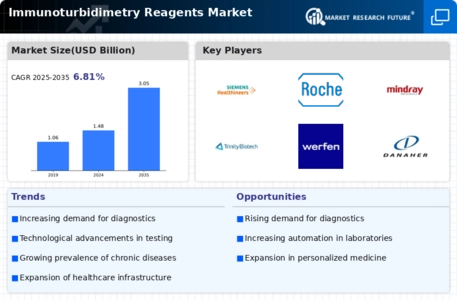Focus on Personalized Medicine
The trend towards personalized medicine is reshaping the Immunoturbidimetry Reagents Market, as healthcare providers increasingly tailor treatments based on individual patient profiles. This approach necessitates precise diagnostic tools that can accurately measure specific biomarkers, which is where immunoturbidimetry plays a crucial role. The ability to customize treatment plans based on immunological responses is likely to enhance patient outcomes and optimize resource utilization in healthcare settings. As the demand for personalized medicine continues to grow, the market for immunoturbidimetry reagents is expected to expand, driven by the need for advanced diagnostic capabilities.
Regulatory Support and Standardization
Regulatory bodies are increasingly recognizing the importance of standardization in diagnostic testing, which is positively impacting the Immunoturbidimetry Reagents Market. Initiatives aimed at establishing guidelines and quality control measures for immunoturbidimetry reagents are fostering greater confidence among healthcare providers. This regulatory support is likely to enhance the credibility of immunoturbidimetry as a reliable diagnostic tool, encouraging wider adoption across various healthcare settings. Furthermore, as regulatory frameworks evolve, they may facilitate innovation in reagent development, thereby driving market growth. The emphasis on quality and standardization is expected to play a pivotal role in shaping the future of the market.
Rising Demand for Point-of-Care Testing
The Immunoturbidimetry Reagents Market is witnessing a notable shift towards point-of-care testing (POCT), driven by the need for rapid and accurate diagnostic results. POCT allows for immediate decision-making in clinical settings, which is particularly crucial in emergency situations. The convenience of on-site testing is appealing to both healthcare providers and patients, leading to an increased adoption of immunoturbidimetry reagents in various healthcare facilities. Market analysis indicates that the POCT segment is expected to grow significantly, with a projected CAGR of around 8% over the next few years, reflecting the growing preference for decentralized testing solutions.
Increasing Prevalence of Chronic Diseases
The rising incidence of chronic diseases such as diabetes, cardiovascular disorders, and autoimmune conditions is a significant driver for the Immunoturbidimetry Reagents Market. As healthcare providers seek efficient diagnostic tools to monitor and manage these conditions, the demand for immunoturbidimetry reagents is expected to rise. According to recent statistics, chronic diseases account for nearly 70% of all deaths worldwide, underscoring the urgent need for effective diagnostic solutions. This trend is likely to propel the market forward, as healthcare systems increasingly adopt immunoturbidimetry for routine testing and disease management, thereby expanding the market's reach.
Technological Advancements in Immunoturbidimetry
The Immunoturbidimetry Reagents Market is experiencing a surge in technological advancements that enhance the accuracy and efficiency of diagnostic testing. Innovations in reagent formulations and automated systems are streamlining laboratory workflows, thereby reducing turnaround times for test results. For instance, the integration of artificial intelligence in immunoturbidimetry systems is likely to improve data analysis and interpretation. Furthermore, advancements in microfluidics technology are enabling the development of more sensitive and specific reagents, which could potentially lead to better patient outcomes. As a result, the market is projected to grow at a compound annual growth rate (CAGR) of approximately 6% over the next five years, driven by these technological improvements.


















Leave a Comment